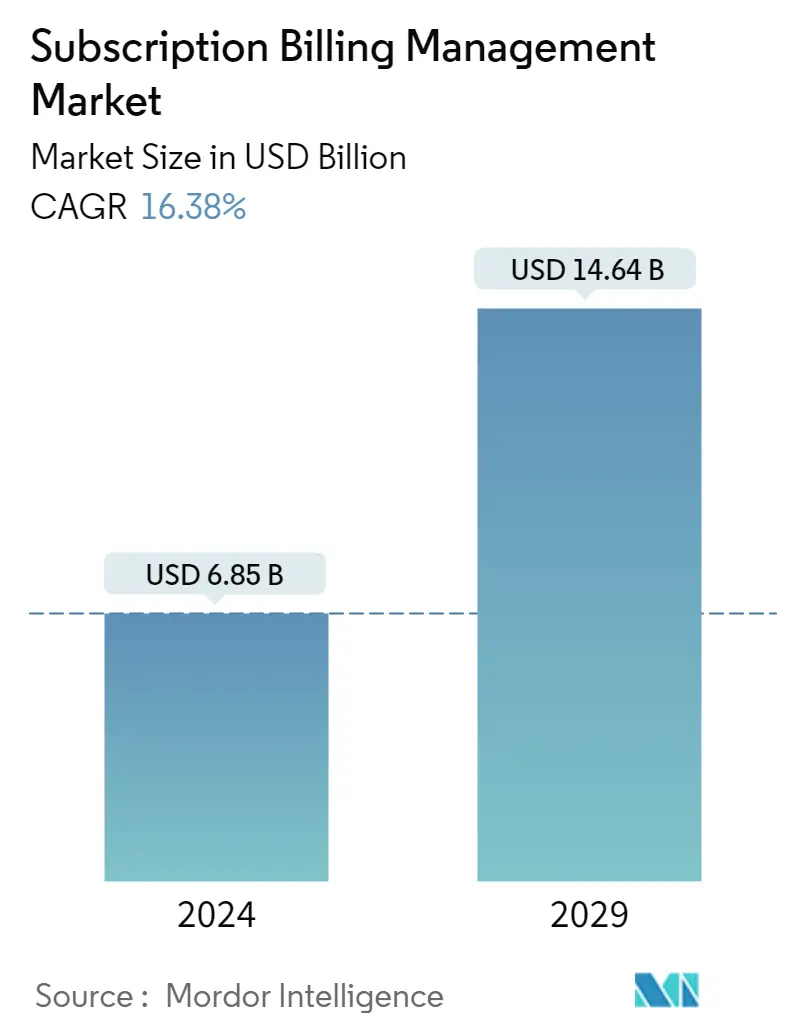
| Study Period | 2019 - 2029 |
| Market Size (2024) | USD 6.85 Billion |
| Market Size (2029) | USD 14.64 Billion |
| CAGR (2024 - 2029) | 16.38 % |
| Fastest Growing Market | Asia Pacific |
| Largest Market | North America |
| Market Concentration | Low |
Major Players
*Disclaimer: Major Players sorted in no particular order |
Subscription Billing Management Market Analysis
The Subscription Billing Management Market size is estimated at USD 6.85 billion in 2024, and is expected to reach USD 14.64 billion by 2029, growing at a CAGR of 16.38% during the forecast period (2024-2029).
The increasing adoption of digitization and demand for flexibility have given rise to subscription-based businesses across sectors. Numerous businesses' rising adoption of subscription-based models leads to improved customer retention rates.
- The expansion of the large customer base necessitates the automation and uniformity of the subscription billing procedure. In addition, businesses are putting more effort into maximizing client retention through an improved customer experience. Thus, more industries are anticipated to embrace subscription billing management systems during the projection period.
- Software-based subscription billing solutions are becoming increasingly popular among businesses since they minimize operating expenses, simplify monetization methods, and lessen billing errors. The solutions automate the invoicing and billing process by incorporating numerous technologies, including artificial intelligence, machine learning, and cloud computing. They assist businesses in gaining crucial client insights that are necessary for enhancing the customer experience and boosting customer retention.
- Market acceptance is anticipated to be boosted by the growing use of subscription-driven business models across various sectors, from manufacturing to financial institutions.
- Although the COVID-19 pandemic was predicted to have a minimal impact on market expansion due to the varying rates at which different industries adopted subscription services, it ended up being both beneficial and disruptive to those markets.
Subscription Billing Management Industry Segmentation
Subscription billing management enables businesses to automate their billing and invoicing processes and automatically renew their customers' subscriptions on time. It helps subscription-based businesses meet the growing demand for a reduction in billing errors by simplifying and automating the complex monetization process and establishing a new subscription billing and recurring revenue management capability.
The subscription billing management market is segmented by deployment mode (on-premise, on-cloud), size of the organization (small and medium enterprises, large enterprises), end-user industry (retail and e-commerce, BFSI, IT, and telecom, media, and entertainment, public sector, and utilities), and geography (North America, Europe, Asia-Pacific, Latin America, the Middle East, and Africa). The market sizes and forecasts are provided in terms of value (USD) for all the above segments.
| On-Premise |
| On-Cloud |
| Small and Medium Enterprises |
| Large Enterprises |
| Retail and E-commerce |
| BFSI |
| IT and Telecom |
| Media and Entertainment |
| Public Sector and Utilities |
| Other End-user Industries (Transportation and Logistics, Educational Institutions) |
| North America |
| Europe |
| Asia-Pacific |
| Latin America |
| Middle East and Africa |
Subscription Billing Management Market Size Summary
The Subscription Billing Management Market is experiencing significant growth, driven by the increasing adoption of subscription-based business models across various sectors. This shift is largely due to the demand for digitization and flexibility, which has led to improved customer retention rates. As businesses expand their customer bases, the need for automated and standardized subscription billing processes becomes crucial. Software-based solutions are gaining traction as they reduce operational costs, streamline monetization, and minimize billing errors. These solutions leverage technologies like artificial intelligence, machine learning, and cloud computing to automate invoicing and billing, providing businesses with valuable insights to enhance customer experience and retention. The market is further bolstered by the growing use of subscription-driven models in industries such as media, entertainment, and financial services, which are rapidly transitioning to digital platforms.
North America is poised to lead the subscription billing management market, supported by major industry players like SAP, Salesforce, Oracle, and Amazon Web Services. The region's growth is fueled by the increasing adoption of cloud-based services and mobile devices, which facilitate the automation of subscription processes. Businesses are also adopting paperless billing methods to reduce costs and improve financial management. The competitive landscape is fragmented, with numerous players offering innovative solutions to capture market share. Strategic partnerships and technological advancements, such as those announced by Salesforce and Amazon Web Services, are expected to drive further growth and innovation in the market. These developments highlight the importance of effective billing strategies in developing flexible business procedures and enhancing customer engagement.
Subscription Billing Management Market Size - Table of Contents
1. MARKET DYNAMICS
-
1.1 Market Drivers
- 1.1.1 Growth of Subscription Based Businesses
- 1.1.2 Increasing Focus of Businesses on Increasing Customer Retention by Reducing the Subscriber Churn Rate
- 1.1.3 The Need for Reduction in Complex Monetization Models and Reducing Billing Errors Due to the Increase in Size of Customers
-
1.2 Market Restraints
- 1.2.1 Data and Privacy Concerns
2. MARKET SEGMENTATION
-
2.1 Deployment Mode
- 2.1.1 On-Premise
- 2.1.2 On-Cloud
-
2.2 Size of the Organization
- 2.2.1 Small and Medium Enterprises
- 2.2.2 Large Enterprises
-
2.3 End-user Industry
- 2.3.1 Retail and E-commerce
- 2.3.2 BFSI
- 2.3.3 IT and Telecom
- 2.3.4 Media and Entertainment
- 2.3.5 Public Sector and Utilities
- 2.3.6 Other End-user Industries (Transportation and Logistics, Educational Institutions)
-
2.4 Geography
- 2.4.1 North America
- 2.4.2 Europe
- 2.4.3 Asia-Pacific
- 2.4.4 Latin America
- 2.4.5 Middle East and Africa
Subscription Billing Management Market Research FAQs
How big is the Subscription Billing Management Market?
The Subscription Billing Management Market size is expected to reach USD 7.97 billion in 2025 and grow at a CAGR of 16.38% to reach USD 17.02 billion by 2030.
What is the current Subscription Billing Management Market size?
In 2025, the Subscription Billing Management Market size is expected to reach USD 7.97 billion.


